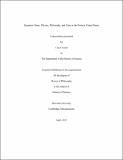| dc.contributor.advisor | Galison, Peter | |
| dc.contributor.author | Crystal, Lisa | |
| dc.date.accessioned | 2013-09-18T15:31:41Z | |
| dc.date.issued | 2013-09-18 | |
| dc.date.submitted | 2013 | |
| dc.identifier.citation | Crystal, Lisa. 2013. Quantum Times: Physics, Philosophy, and Time in the Postwar United States. Doctoral dissertation, Harvard University. | en_US |
| dc.identifier.other | http://dissertations.umi.com/gsas.harvard:10973 | en |
| dc.identifier.uri | http://nrs.harvard.edu/urn-3:HUL.InstRepos:11051191 | |
| dc.description.abstract | The concept of time in physics underwent significant changes in the decades following World War II. This dissertation considers several ways in which American physicists grappled with these changes, analyzing the extent to which philosophical methods and questions played a role in physicists' engagement with time. Two lines of questioning run through the dissertation. The first asks about the professional identities of postwar American physicists in relation to philosophy, as exemplified by their engagement with the concept of time. The second analyzes the heterogeneous nature of time in physics, and the range of presuppositions and assumptions that have constituted this "fundamental" physical concept. The first chapter looks to the development of atomic clocks and atomic time standards from 1948-1958, and the ways in which new timekeeping technologies placed concepts such as “clock”, “second,” and “measure of time” in a state of flux. The second chapter looks to the experimental discovery of CP violation by particle physicists in the early 1960s, raising questions about nature of time understood as the variable “t” in the equations of quantum mechanics. The third chapter considers attempts to unify quantum mechanics and general relativity in the late 1960s, which prompted physicists to question the “existence” of time in relation to the universe as a whole. In each episode considered, physicists engaged with the concept of time in a variety of ways, revealing a multiplicity of relationships between physics, philosophy, and time. Further, in each case physicists brought a unique set of assumptions to their concepts of time, revealing the variety ways in which fundamental conceptsfunctioned and changed in late twentieth century physics. The result is a heterogeneous picture of the practice of physics, as well as one of physics’ most basic concepts. | en_US |
| dc.description.sponsorship | History of Science | en_US |
| dc.language.iso | en_US | en_US |
| dash.license | LAA | |
| dc.subject | History of science | en_US |
| dc.subject | History | en_US |
| dc.subject | Philosophy of science | en_US |
| dc.subject | Atomic Clocks | en_US |
| dc.subject | CP Violation | en_US |
| dc.subject | Physics | en_US |
| dc.subject | Quantum Gravity | en_US |
| dc.subject | Time | en_US |
| dc.subject | United States | en_US |
| dc.title | Quantum Times: Physics, Philosophy, and Time in the Postwar United States | en_US |
| dc.type | Thesis or Dissertation | en_US |
| dash.depositing.author | Crystal, Lisa | |
| dc.date.available | 2013-09-18T15:31:41Z | |
| thesis.degree.date | 2013 | en_US |
| thesis.degree.discipline | History of Science | en_US |
| thesis.degree.grantor | Harvard University | en_US |
| thesis.degree.level | doctoral | en_US |
| thesis.degree.name | Ph.D. | en_US |
| dc.contributor.committeeMember | Kaiser, David | en_US |
| dc.contributor.committeeMember | Canales, Jimena | en_US |
| dash.contributor.affiliated | Crystal, Lisa | |


